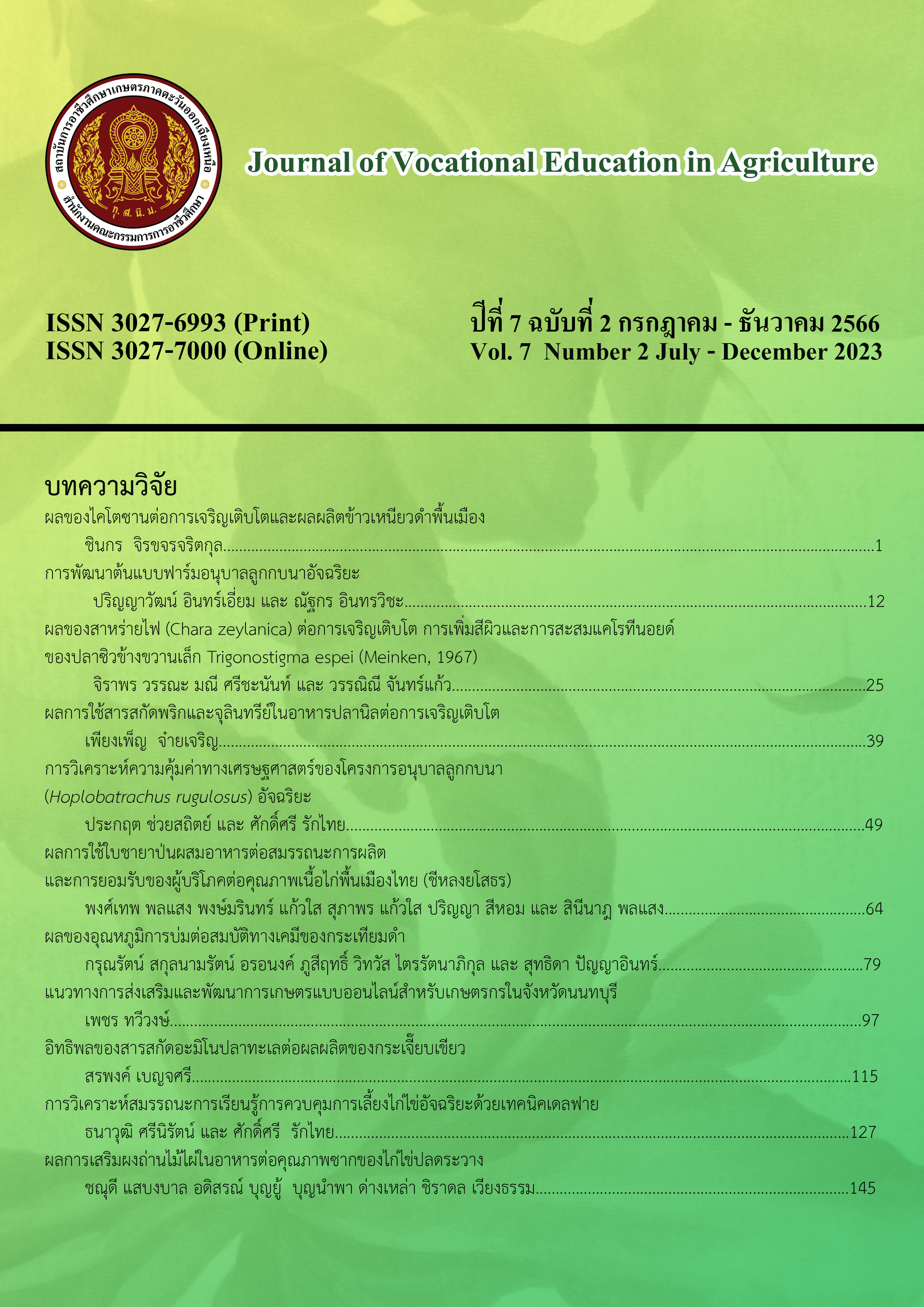Influence of Incubated Temperatures on Chemical Properties of Black Garlic
Main Article Content
Abstract
The present study investigated the influence of incubated temperature on the chemical properties of black garlic obtained from three different kinds from different places including Srisaket (SK), Chiangmai (CM), and China (CN) incubated at 60 and 70°C with 80% RH for 6 weeks. The results revealed that the temperature of 60°C provided black garlic with pH value and total soluble solid higher than that of 70°C at week 6th (p<0.05). Black garlic of SK and CN incubated at 70°C exhibited the highest protein and carbohydrate content, respectively (p<0.05), and was correlated to the quantity observed in fresh garlic. In the contrary, fat and fiber contents detected in black garlic incubated at the same temperature were comparable. At 60°C, CM-black garlic had the highest total phenolics (252.47±12.4 mg G E/g DW) (p<0.05), while SK- and CN-black garlic were similar (181.10±8.42, 175.52±7.84 mg G E/g DW, respectively). CN-black garlic contained the highest total flavonoids (4.122±0.02 mg Cat E/g DW) and total proanthocyanidins (1.52±0.34 mg Cat E/g DW) (p≥0.05), followed by SK-black garlic (1.012±0.10 mg Cat E/g DW, 1.12±0.03 mg Cat E/g DW, respectively), while were similar to SK-black garlic for antioxidant capacity as observed in the final week (week 6th). In accordance, this could be further utilized for developing black garlic as a functional food product.
Article Details

This work is licensed under a Creative Commons Attribution-NonCommercial-NoDerivatives 4.0 International License.
The content and information in articles published in the Journal of Vocational Education in Agriculture are the opinions and responsibility of the article's author. The journal editors do not need to agree or share any responsibility.
Articles, information, content, etc. that are published in the Journal of Vocational Education in Agriculture are copyrighted by the Journal of Vocational Education in Agriculture. If any person or organization wishes to publish all or any part of it or to do anything. Only prior written permission from the Journal of Vocational Education in Agriculture is required.
References
Office of Agricultural Economics. (2023). Exporting garlic. Available from http://mis- app.oae.go.th. Accessed date: 1 May 2023. (in Thai)
Sasaki, J. I., et al. (2007). Processed black garlic (Allium sativum) extracts enhance anti-tumor potency against mouse tumors. Medicinal and Aromatic Plant Science and Biotechnology, 1(2), 278-281.
Choi, I. S., et al. (2014). Physicochemical and antioxidant properties of black garlic. Molecules, 19, 16811-16823.
Lu, X., et al. (2017). Composition analysis and antioxidant properties of black garlic extract. Journal of Food and Drug Analysis, 25, 340-349.
Kima, J-S., et al. (2013). Comparison of phenolic acids and flavonoids in black garlic at different thermal processing steps. Journal of Functional Foods, 5, 80-86.
Bae, S. E., et al. (2014). Changes in S-allyl cysteine content and physicochemical properties of black garlic during heat treatment. LWT– Food Science and Technology, 55, 397-402.
Sato, K., et al. (2006). The synthesis of new azoniathiahelicenes. Journal of Heterocyclic Chemistry, 43(1), 177-181.
Ichikawa, N. (2002). A yeast mitochondrial ATPase inhibitor interacts with three proteins that are easy to dissociate from the mitochondrial inner membrane. Journal of Biochemistry, 132(4), 649-654.
Yuan, H., et al. (2018). An analysis of the changes on intermediate products during the thermal processing of black garlic. Food Chemistry, 239, 56–61.
AOAC. (2000). Official methods of analysis of the AOAC. 18th ed. Washington, DC: AOAC.
Cardozo, M. L., et al. (2011). Antioxidant and anti-inflammatory activity characterization and genotoxicity evaluation of Ziziphus mistol ripe berries, exotic Argentinean fruit. Food Research International, 44, 2063-2071.
Sakulnarmrat, K. & Konczak, I. (2012). Composition of native Australian herbs polyphenolic-rich fractions and in vitro inhibitory activities against key enzymes relevant to metabolic syndrome. Food Chemistry, 134, 1011-1019.
Zhang, X., et al. (2015). Effect of temperature on the quality of black garlic. Journal of the Science of Food and Agriculture, 96(7), 2366-2372.
Liang, T., et al. (2015). Comprehensive NMR analysis of compositional changes of black garlic during thermal processing. Journal of Agricultural and Food Chemistry, 63(2), 683-691.
Kimura, S., et al. (2017). Black garlic: a critical review of its production, bioactivity, and application. Journal of Food Drug Analysis, 25, 62-70.
Turan, E. & Simsek, A. (2021). Black garlic as a substitute for fresh garlic to reduce off-flavor and enhance consumer acceptance and bioactive properties in cemen paste. Journal of Food Processing and Preservation, 46(2), e16246.
Yuan, H., et al. (2016). The comparison of the contents of sugar, Amadori, and Heyns compounds in fresh and black garlic. Journal of Food Science, 81, C1662-C1668.

